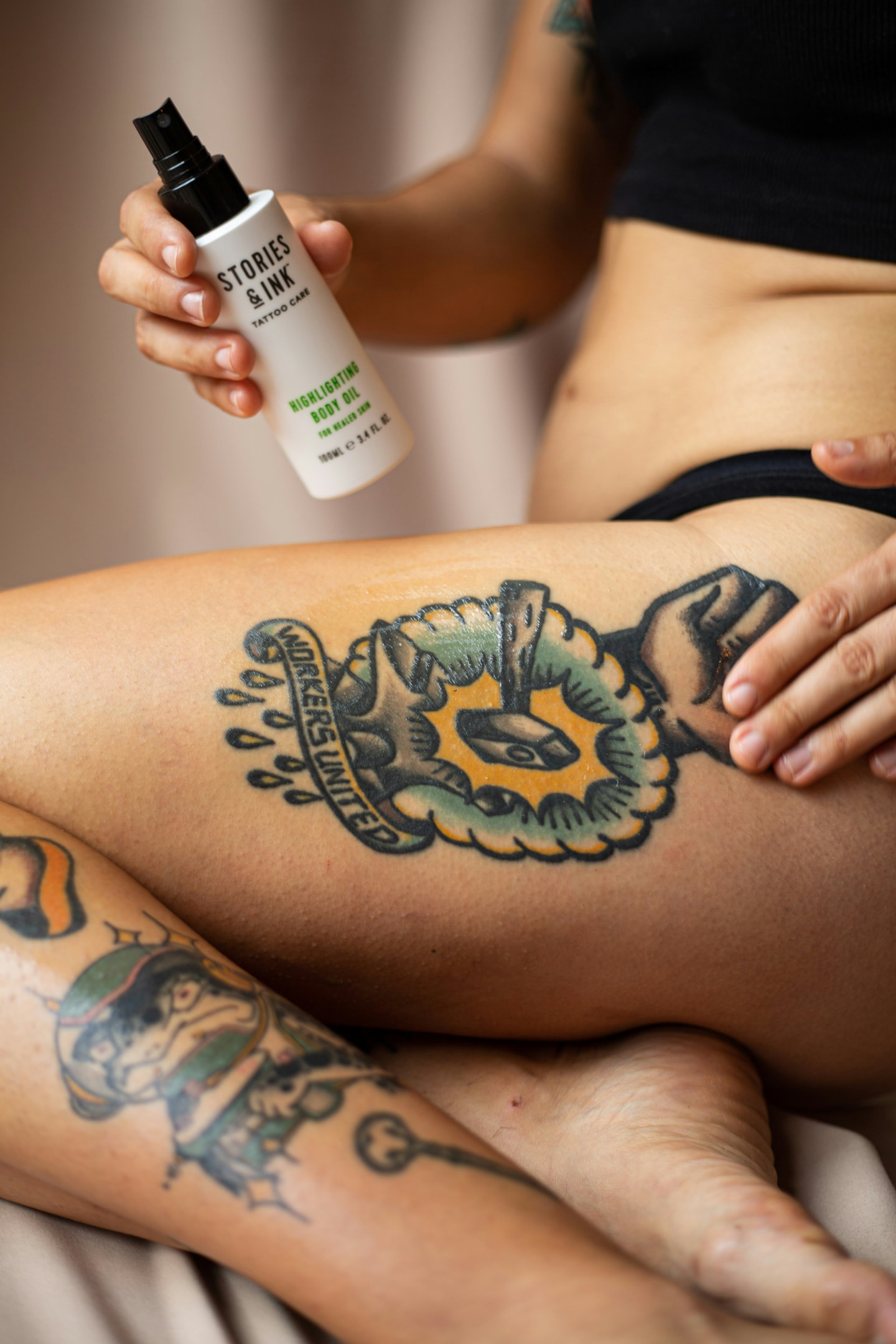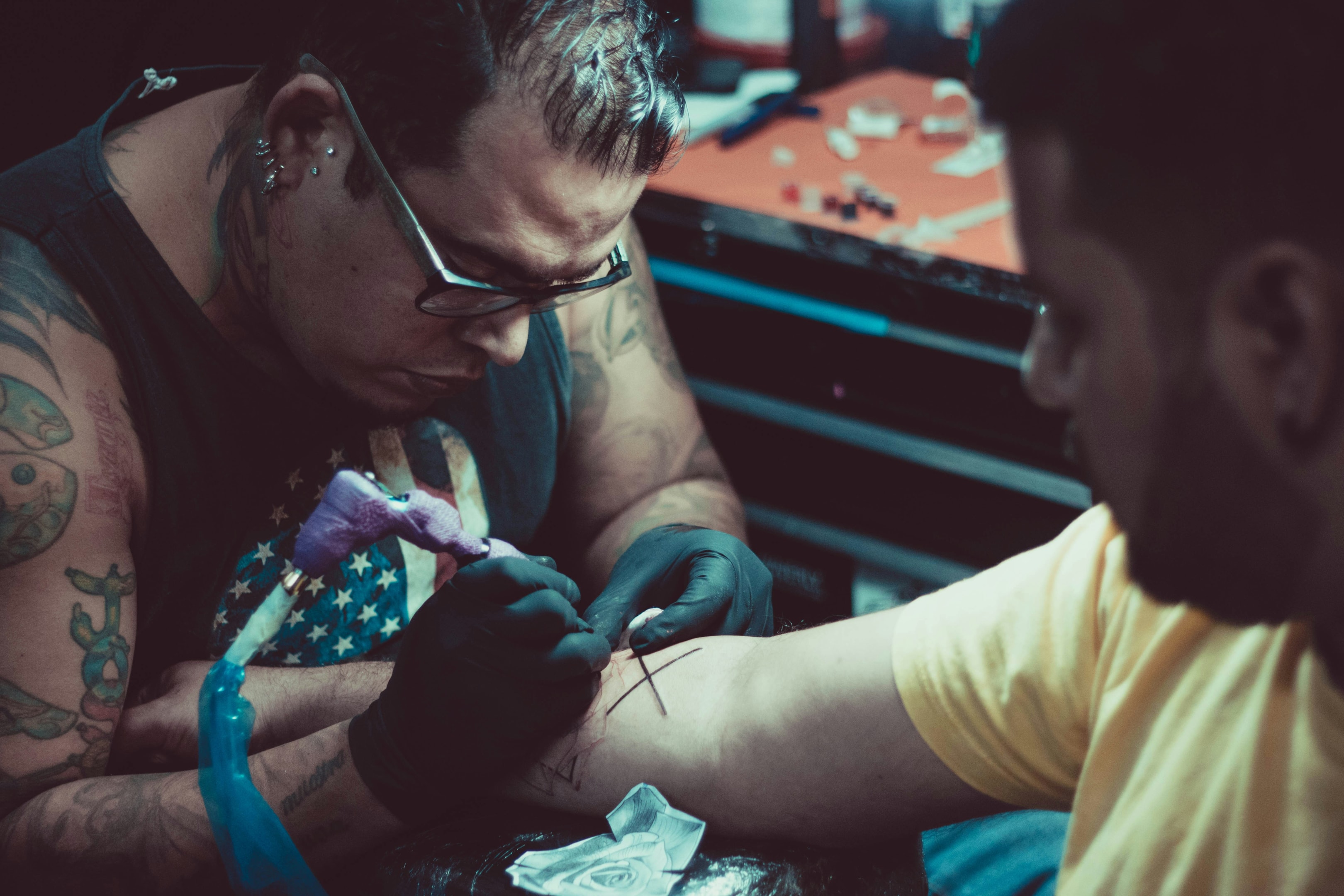How to Take Care of a Tattoo
Table of Contents
 Photo by Jordan Whitt on Unsplash
Photo by Jordan Whitt on Unsplash
After months of discussion and planning, you’ve finally taken the plunge to get that new tattoo you’ve been wanting for a while. You carefully perused tattoo ideas, working directly with your tattoo artist to ensure that it’s exactly what you were looking for.
There’s nothing quite like the reveal of new body art for the first time. Whether it’s a small tattoo design on your arm or a full back tattoo, seeing your vision come to life is unlike anything else.
Now, that the body art is done, you want to make sure that your tattoo stays looking great, and that you give your body the care it needs. Your tattoo artist should be sending you on your way with a clean and fresh tattoo, after they follow the recommendations issued by the U.S. Food and Drug Administration to prevent contamination. But, what steps should you take to ensure your tattoo is cared for properly once you leave the shop? We’ll discuss tattoo aftercare in more detail below, providing an in-depth guide to how to care for your new tattoo to ensure the proper healing process.
The Few Hours After You Get the Fresh Tattoo
If you’ve selected a reputable tattoo artist and tattoo shop, you should be sent home with a clean tattoo that has dressing on it. You should also be given instructions on how long you need to keep the dressing on the tattoo for before you can remove it.
In most cases, you’ll be able to remove any plastic wrapping around the tattoo as well as gauze after a few hours or so. Many tattoo artists will apply a thin layer of an adhesive applied to your new tattoo that’s supposed to last for a few more days, and this is perfectly fine.
Before you remove any of the dressing covering your tattoo, ensure that your hands are thoroughly clean. Then, peel the wrap back carefully to unveil the tattoo.
Clean Your Tattoo
 Photo by Stories & Ink Tattoo Care on Unsplash
Photo by Stories & Ink Tattoo Care on Unsplash
Wash the tattoo area with lukewarm water as well as soap that doesn’t have any fragrance. Pat your skin dry lightly with a clean paper towel, and then after a few more minutes, apply a lotion, ointment or other tattoo aftercare products over top of the tattoo.
Don’t be worried if the tattoo is slightly warm, or if there are any fluids in the area. It might be just excess ink that leak from the tattoo site. This is completely normal to be happening at the tattooed area.
A Few Days Out in the Healing Process
In the next few days, your tattoo should look like it’s fading on your skin. It may look dull and cloudy, and that’s OK. This all happens as part of your skin’s natural healing process, and while this happens, you might notice that scabs form on your tattooed skin.
Gently Wash Your Tattoo with Fragrance Free Products
Your tattoo artist should provide recommended tattoo aftercare steps, and that starts with ensuring that you wash your tattoo a few times a day with antibacterial soap that is fragrance free and warm water. Gently pat the tattoo dry, and ensure it is thoroughly dry before you apply the lotion or antibiotic ointment that your tattoo artist recommended for tattoo aftercare.
Remove Adhesive by Gently Peeling
As the first week comes to an end and your tattoo heals, you can carefully remove the adhesive, which is sometimes called “second skin.” Before you peel it back gently, ensure that your hands are thoroughly clean.
One to Two Weeks Out Aftercare Instructions
By the end of the second week of tattoo care, any scabs that hardened should start to break off. It’s very important that you don’t pull scabs off or pick at them, as that could leave scars and/or draw out ink from the tattoo.
If you’re asking “why is my tattoo itchy?” you don’t have to worry, as it’s normal. Just apply either a moisturizer that doesn’t have any alcohol and is fragrance free to help relieve that itch. Make sure you don’t use any essential oils or petroleum based products.
What you should look for at this point is if your new tattoo is swollen and red, because that could be an indication of an infection and that you might need a medical procedure. If you notice this, make sure to visit your tattoo artist again or consult with a medical professional for further tattoo aftercare instructions.
Two to Four Weeks Out
Your tattoo will enter the final healing stages over the second half of the month. You should notice that the scabs on your skin are almost completely gone at this point, and your tattoo is almost healed.
Apply a Thin Layer of Moisturizer to Dry Skin
There might be dead skin around still and you might have dry skin, but that will clear up in time. It may take longer for bigger tattoos, or if you needed any touch ups. If the tattoo looks dull and dry on your skin, make sure to continue applying moisturizer to it so that the tattoo appears hydrated. It’s also important that you stay hydrated to promote healing of your tattoo.
At the end of this first month, the skin’s outer layers should be completely healed. It could take about three to four months for the skin’s lower layers to be fully healed.
About 90 days out, you should be able to see the vivid and bright custom tattoo that you designed and dreamed of.
Long Term Tattoo Aftercare Instructions

Photo by Javier Contreras on Unsplash
The first month after your new tattoo is the most important one in the healing process. Following the tips above will help ensure that your tattoo and skin appears as you intended it to, and that you prevent infection in your skin.
There are also some things that you should avoid doing in this time period to ensure fully healed tattoos.
Avoid Direct Sunlight
Any new tattoo is very sensitive to the sun’s harmful UV rays — whether you got a simple tattoo or something intricate. The healing process of your tattoo depends on a number of factors, but too much sun exposure can cause your tattoo to fade and also interfere with the healing process.
You should generally avoid direct sunlight for at least two weeks following your tattoo as your skin heals. If you have to be outside, make sure to have your tattoo covered by wearing loose fitting clothing and not tight clothing.
After your tattoo is fully healed, it’s also important to apply sunscreen that’s specifically formulated for new tattoos. Only use dye free and products that can protect you from the sun’s rays as your tattoo starts to heal.
Avoid Certain Activities
You should also avoid strenuous activities such as working out for a month or so as part of normal tattoo aftercare. It’s a good idea to even wait about two days before even doing light activities such as biking or walking briskly — and make sure that you gently wash your tattoo any time you do engage in physical activity so your tattoo heals properly.
Wear Loose Clothing
It’s also advisable to wear clothing that is loose and breathable while your tattoo is healing. Tight clothing is susceptible to sticking to gels or lotions, and can actually pull scabs off, too.
Don’t Go Swimming to Keep Your Tattoo Clean
Finally, avoid getting into a hot tub, pool or swimming in oceans or lakes for at least three weeks after a tattoo. You can shower or bathe, of course, but these other forms of water can have chemicals and bacteria that could be harmful to your new tattoo.
What About Dry Healing for Tattoo Aftercare?
The dry healing process is another form of tattoo aftercare. It’s tattoo care that involves keeping the tattoo clean like normal, but doesn’t use any antibiotic ointment or other skin care products. It relies instead on just making sure you clean your tattoo gently and pat dry until the tattoo is fully healed.
Some people prefer this tattoo aftercare approach since it could help them avoid having an allergic reaction as their tattoo heals. Generally speaking, though, it’s not a recommended tattoo aftercare approach.
Design the Tattoo of Your Dreams
By following these tips above, you’ll be ensuring that you are taking care of your new tattoo the best you can. This will help you heal properly and also have the tattoo you dreamed of.
It can be challenging to design a tattoo on your own, but not any more. At Tattoos.ai, we provide an AI tattoo generator that’s free to try and allows you to play around with styles and placement so you can get the tattoo of your dreams.